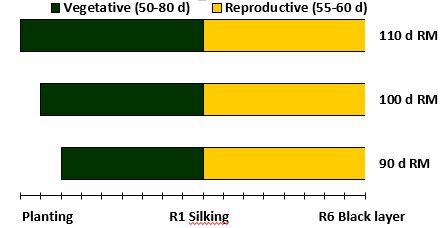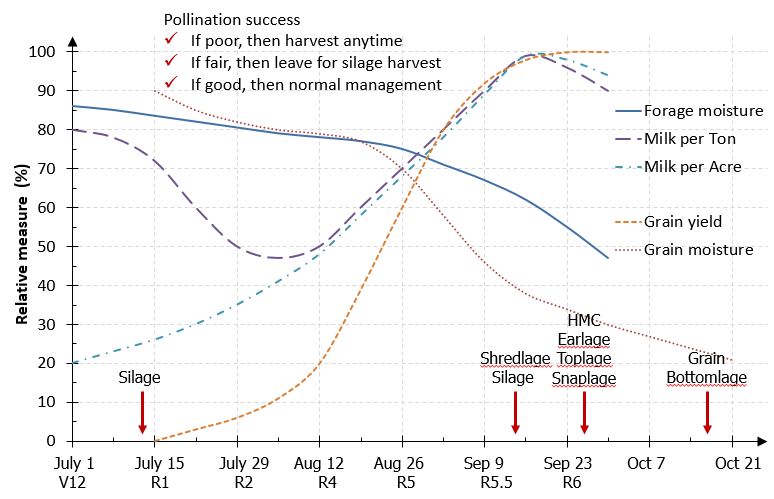Cool Growing Seasons
Originally written July 31, 2014. Last updated
August 21, 2014
Corn produced in the northern Corn Belt of the U.S. is often challenged
by growing seasons that are cool accumulating substantially fewer
Growing Degree Units (GDUs). During cool growing seasons, especially when planting is delayed due to wet spring conditions, growers are concerned about whether their corn is vulnerable and will reach maturity before normal frost dates. Often the range in planting dates have implications at harvest time, especially for silage because grain and dairy producers often negotiate the sale of corn in fields that are borderline for development.
Some examples of 'cool' years that had delayed planting are
2013,
2009, 1992 and 1991.
Most hybrids require about 55 to 60 days to develop from the silk stage to physiological maturity
(Figure 1). Hybrid maturity differences in development time occur primarily from emergence to silking, not from silking to maturity.

Figure 1.
Time Span of Vegetative and Reproductive Stages During the Life Cycle of
Corn in Wisconsin
Most concern exists when corn does not reach the silk stage (R1) until early August or later. Killing frosts can easily occur by late September, so corn silking in early August would not be safe from major yield reductions due to frost until early October.
At the
dent stage (R5), corn has accumulated 75-85% of silage yield and 60-75% of grain yield and needs about 27-32 days to avoid significant yield reductions due to frost (Table 1).
In order to avoid yield reductions caused by frost, corn intended for silage should be silking by late August, while corn intended for dry grain should reach the dent stage by September 1.
Table 1. The relationship between kernel growth stage and development.
|
Stage
|
Calendar days to maturity
|
GDUs to maturity
|
Percent of maximum yield
Grain Silage
|
Moisture content (%)
Grain Silage
|
|
R1: Silking
|
55-60
|
1100-1200
|
0
|
45-50
|
---
|
80-85
|
|
R2: Blister
|
45-50
|
875-975
|
0-10
|
55-60
|
85-95
|
80-85
|
|
R3: Milk
|
35-40
|
750-850
|
10-30
|
60-65
|
70-85
|
80-85
|
|
R4: Dough
|
30-35
|
650-750
|
30-60
|
65-75
|
60-70
|
75-80
|
|
R5: Dent
|
27-32
|
425-525
|
60-75
|
75-85
|
50-55
|
70-75
|
|
R5.5: 50% Kernel milk
|
13-18
|
200-300
|
90-95
|
100
|
35-40
|
65-70
|
|
R6: Black layer
|
0
|
0
|
100
|
95-100
|
30-35
|
55-65
|
Figure 2 describes the typical pattern of forage and grain
development during the growing season. A "double-peak" for forage
quality (Milk per Ton) is observed at flowering (R1) and R5.5 (50%
kernel milkline). After R5 (Dent stage), forage moisture decreases at a more rapid
rate. Forage yield (Milk per Acre) is greatest around R5.5. Grain yield
increases until R6 (Black layer = Physiological maturity). Grain
moisture drops at a more rapid rate than forage moisture after R5. Optimum moisture when cutting corn can be achieved by raising or
lowering the cutter bar. The moisture swing is about 3-4%. The wettest
part of the plant is the lower stalk, while the driest is the grain.

Figure 2. Normal pattern of corn forage and grain development in
Wisconsin. Arrows indicate when corn of various uses can be harvested
based upon moisture.
To predict whether corn will mature before frost note the hybrid maturity, planting date and tasseling (silking) date of the field.
For silage, add 42-47 days on to this date to predict 50% kernel milk,
while for grain, add 55- 60 days to predict maturity.
These dates are guidelines which will
require further in-season decisions as the season unfolds.